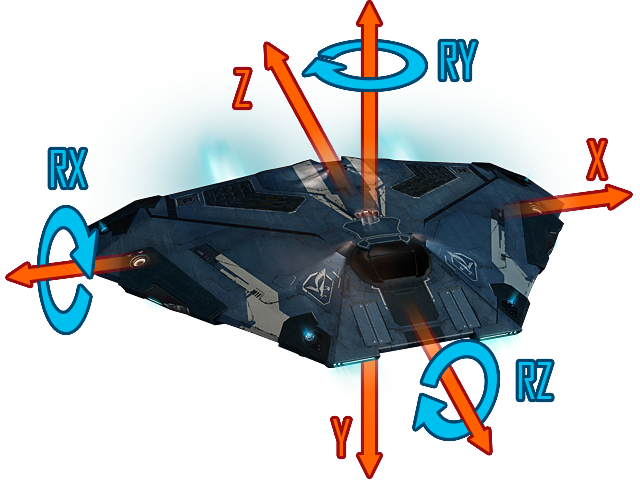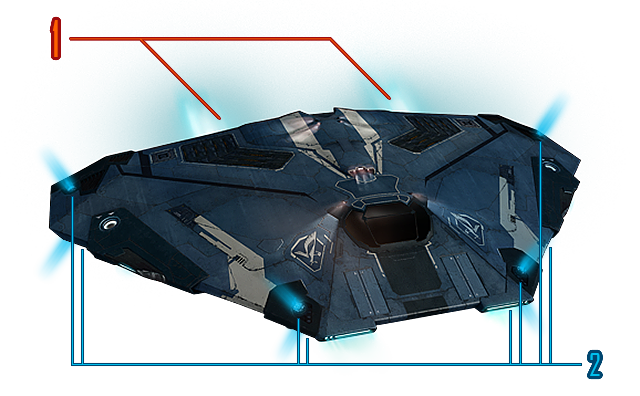Basics | Introduction to the flight model Elite: Dangerous Guide
Last update: 11 May 2016
The basic difference between the Elite: Dangerous and other popular classics among the cosmic simulators is the so called Newton's Flying system. The first crucial difference is the number of axes on which the ship can maneuver. Apart from the three basic axes: RX (rising/declining), RY (veering) and RZ (turning via the axis going along the hull) offers also the axes; X, Y, Z.
 These three additional implements are used for moving the ship by vectors - which is called the strafing. You can strafe horizontally (left-right), vertically (up -down) and 'in depth' (forward backwards). These six degrees of freedom or 6DOF enables you flying in true three dimensions. The closest comparison to such system is steering a submarine or a helicopter (up to some degree).
These three additional implements are used for moving the ship by vectors - which is called the strafing. You can strafe horizontally (left-right), vertically (up -down) and 'in depth' (forward backwards). These six degrees of freedom or 6DOF enables you flying in true three dimensions. The closest comparison to such system is steering a submarine or a helicopter (up to some degree).
Thus we had come to another aspect of the flight model in the Elite: Dangerous. The most crucial here is the First rule of the Newton's law of motion:
When viewed in an inertial reference frame, an object either remains at rest or continues to move at a constant velocity, unless acted upon by an external force.
This rules applies to our ship in the matters of playability. If you will accelerate with your ship (without any flight support) it will be drifting in the space with the same velocity as long as there won't be anything to stop it. The same goes when it doesn't move.

1. Main Engine, 2. Bow Thrusters
Such flight model would be enormously hard to tackle if not for the cockpit's computer with its power steering. Every ship is equipped with the main engine (1), which drives the ship in the direction the nose is pointing. For the change of the direction or strafing the ship uses the Bow Thrusters (2) placed on both sides of the hull (both the top as the bottom).
Through this system the computer can read the signals send by the rod and change it into the trajectory of the flying in the space. Pilot doesn't have to process any complicated calculations to fly or keep the speed up, it comes naturally.
This looks a bit different without using power steering though, when the pilot has to correct every change of direction. It requires reflex and dexterity but it gives the player the possibility of performing extraordinary maneuvers (Advanced flight techniques chapter). Turning off the power steering doesn't turn it off 100% as the computer will be always helping more or less. It doesn't influence the speed or the direction though.
No matter whether the Power steering is on or off, you have to remember that the ships is influenced by the space and inertia. This is the reason not to change its direction in the matter of seconds as the Bow thrusters need some time to adjust.
It would appear that because of using the advanced physics rules, it would be possible to endlessly accelerate the ship, but the game's physics won't let that happen and thus the ships has their maximum speed predetermined.

Let's imagine the situation when the player approaches the station going with the speed of 100.000 KM/s - not to fast considering the galaxy's scale, but it would be a massive speed for the pilot who's the littlest mistake would highly affect the ship. It could simply end with a big 'boom' both of the ships as the stations which would then be turned into the stardust.
Another reason for limiting the maximum speed is also for the playability, this time concerning the difficulty of targeting and shooting other ships. It would be nearly impossible to counter the other ship's attack and it would simply look like a jousting, binary.
As you can see these limitations seem to be fair because of the reasons of safety and playability. We can surely assume that once the space flights will be commercialized the way the game shows them, everyone will be under such limitations. Also, in order to travel in the speed of light, you can also turn on the Frame Shift Drive, further exploited in the Travelling and navigation chapter.
Speaking of which, the maximum speed is different for each ship, dependently for its weight. How to justify that? The bigger weight, the bigger threat for the pilot and his surroundings, thus the maximum speed is lower for the heavier ships.
Another vital aspect concerning the ships' speed is the optimum speed which makes the maneuvering easier. It is also different for each vehicle model. The in-game interface provides you with the crucial information on what to do to find, and later keep the perfect speed. If the speed is too high, the ship will have problems with turning, when the speed is too low on the other hand, the steering is not provided with enough power to turn the ship.

The speed gages is distinguished with a blue speed range which has to be kept in order to keep the ship's full potential in maneuvering. It is commonly referred to as a "blue sweet spot". Keeping the right amount of speed is crucial when dealing with a difficult terrain (asteroids' field). There are very few exceptions in which going higher than the BSC would be sensible (fleeing or chasing).

Of course, there is a method to increase the performance of the engines and bow thrusters. In the Elite: Dangerous you can manually distribute the power between the engines, weapons and systems. The only unchangeable unit here is the amount of the whole power and giving more power on some components lowers the amount of the power on the others. More on that in the Interface chapter.

In case of a sudden need to escape, chase or any other sudden and extreme situation, you can always use the afterburner. It increases the maximum speed of the ship for a while but the engines need to cool down afterwards. The most effective way is giving the maximum power on the engines and then using afterburner. It gives the highest speed possible for your ship. The speed of cooling down the engines depends on the power given to the engines. Pressing the button for an after burner longer than a taping is ineffective as this component works binary as a short speed injection.

One of the specific element of the Elite is the limited range of turning on the RY axis. Such characteristic may be well known for the veterans of the old space simulators. If the pilot wants to turn around, he has to turn the machine on the RZ axis (semi barrel roll), and them pick the nose up. It is justified by the planes' construction and the aerodynamics in the real life, but not in Elite. The authors made it to make the game make the game more fun and easy to play. Whether you like it or not, such limitations also takes their part in balancing the differences between the ships. It almost eliminates the "turreting" (hovering in one spot and just turning the ship to make the targeting easier in the way a turret would move). A proper fight requires from the player keeping a sufficient speed and thus somewhat uncovering him/herself on some of the opponents' attacks. Realism may have suffered because of that, bat the dynamics surely gain at the same time.
